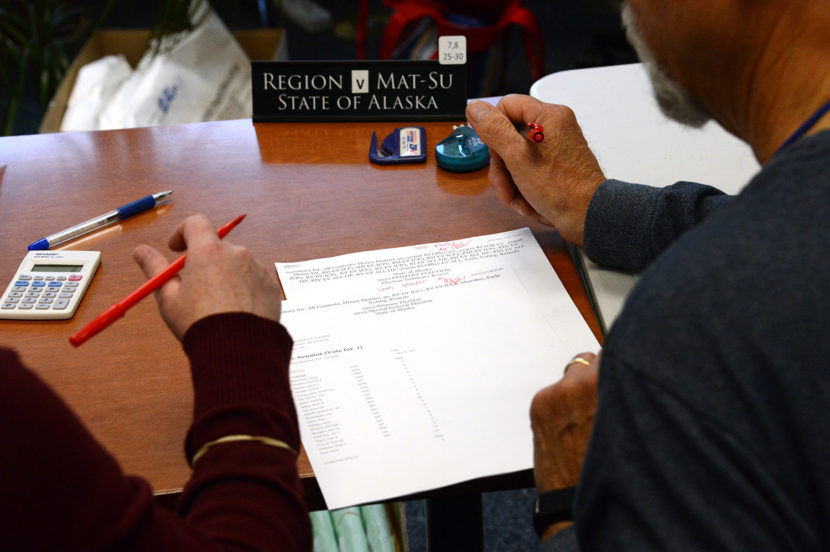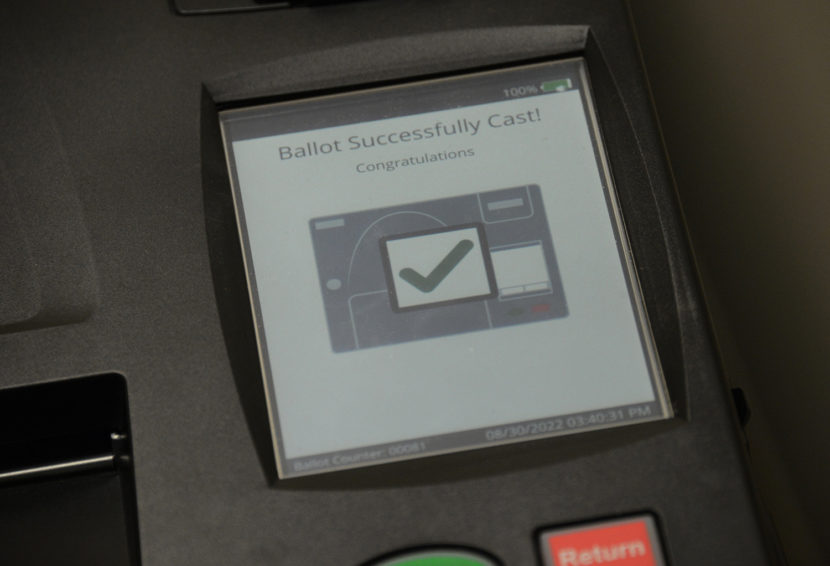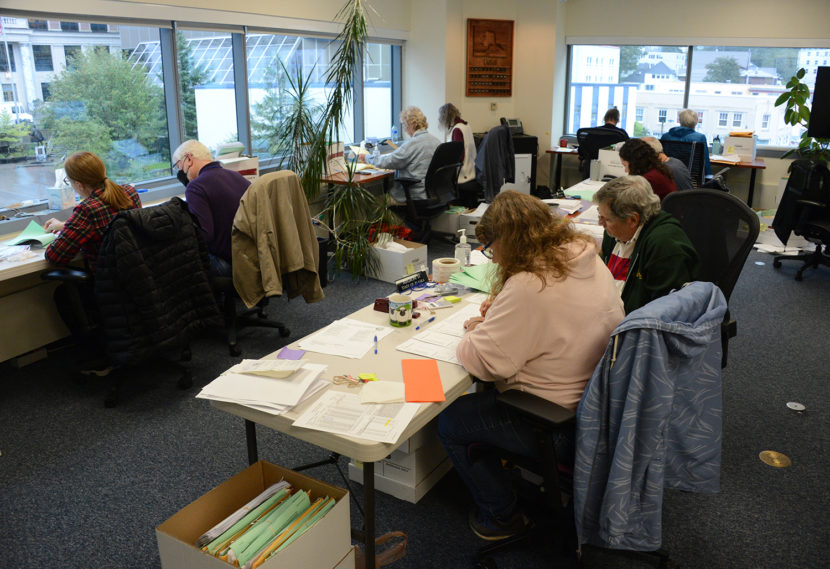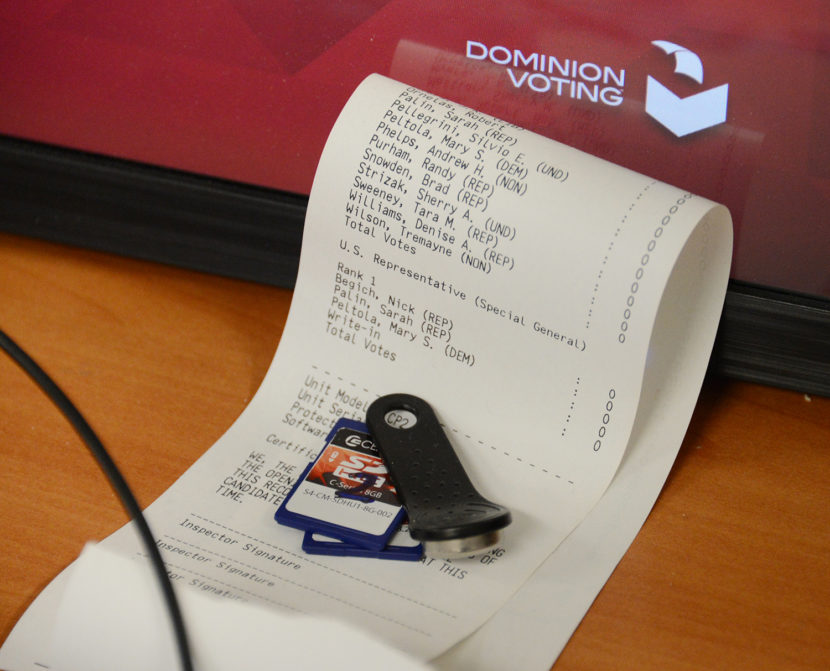
The Alaska Division of Elections will announce the unofficial winner of the special election to replace Congressman Don Young in a 4 p.m. livestream broadcast on the division’s Facebook page.
Though certified results won’t be available until later this week and a few votes may remain uncounted on Wednesday, the result is expected to bring decisive results in Alaska’s first ranked choice election.
Alaskans will be watching to see who represents the state in the U.S. House of Representatives for the next four months, but national observers will be watching as well.
“The Division of Elections has officially run the geographically largest, physically largest, ranked choice voting ever in American history,” said Chris Hughes, policy director of the national Ranked Choice Voting Resource Center, a national nonprofit devoted to informing the public about ranked choice voting.
How we got here
In November 2020, following a multimillion-dollar electoral campaign, Alaskans voted by a narrow margin to approve Ballot Measure 2, which created a new election system.
All candidates for an office run in the same primary election, and the top four candidates, regardless of political party, advance to the November general election, where a winner is chosen by ranked choice voting.
After the votes on Ballot Measure 2 were certified — and the results confirmed with a hand count of more than 361,000 ballots — officials began what they thought would be a two-year process of education and implementation.
When Congressman Don Young died in March, forcing a special election, that timeline was cut by three months.
Alaskans chose four candidates in a June special primary election — it was the first statewide election to be conducted principally by mail due to the compressed timeframe — but the No. 3 finisher, nonpartisan candidate Al Gross, withdrew from the race for reasons that remain unclear.
The Division of Elections declined to replace him with the No. 5 finisher, Republican Tara Sweeney, a decision upheld by the Alaska Supreme Court after a lawsuit. The division said it was too late to replace Gross under the law.
That left Republicans Sarah Palin and Nick Begich III, plus Democratic candidate Mary Peltola.
On Aug. 16, the three appeared in two races, one on the front side of the ballot and the other on the back: A pick-one primary for a two-year U.S. House term that begins in January and the state’s first ranked choice election, which will decide who finishes Young’s term.
The winner is expected to take the oath of office at the U.S. Capitol soon after Congress reconvenes in September.

How votes were counted
When it happens on Wednesday afternoon, the ranking behind ranked choice voting won’t be exciting. A Division of Elections official will check a box or click a mouse on a computer screen, and within a few minutes, the results will pop up.
That’s only possible, however, because of a massive effort to collect and scan about 192,000 ballots cast in this election. (That’s about one in three registered voters, and the precise number won’t be known until the results are certified.)
On Aug. 16, tens of thousands of Alaskans cast votes at 401 polling stations spread across the state.
In 270 of those stations, voters stuck their ballots into a scanner atop a ballot box. The scanner recorded the results and transmitted them digitally to elections headquarters in Juneau.
The ballots themselves were collected, as were the scanners’ memory cards, and flown to Juneau for double-checking. In many cases, those sealed packages of ballots arrived one day later, said Tiffany Montemayor, the division’s public relations manager.
At 131 other voting stations — mostly in rural Alaska — voters dropped their ballots into a box without a scanner. At the end of the night, voting officials hand-counted the ballots and called the results into one of five regional offices.
Afterward, the ballots were packaged into sealed boxes and mailed to Juneau for scanning.
Right now, the process isn’t a fast one — on Tuesday afternoon, temporary workers and a member of the division’s full-time staff were feeding the ballots, one by one, through a scanner. (An automatic, batch-fed scanner should be ready by November.)
The by-mail process has also caused some problems because of the slow pace of mail delivery. As of Tuesday, the ballots of 10 precincts hadn’t arrived in Juneau, Montemayor said. If they arrive before 4 p.m. Wednesday, they’ll be scanned and included in the result that day.
As long as they arrive before certification, they’ll be included in the total, Montemayor said. She said the division will be sending November’s ballots by express mail.
Absentee ballots were sent to each of the regional offices based on the voter’s home address, and election officials have been verifying ballot envelopes against the state’s voter rolls, then scanning the ballots within if the vote was valid.
Questioned ballots — those flagged for special attention for one of a variety of reasons — have gone through a similar review process.
In the end, all valid ballots — whether they were cast in person on election day, in early voting or by mail — end up going through a scanner.

How the sorting works
When the appropriate button is pressed on Wednesday, the software program in charge of doing the ranking behind ranked choice voting starts a step-by-step process.
First, ballots that have no votes are dropped from the total.
As of Tuesday, about 3,900 voters submitted blank ballots, effectively voting for “no one.”
The other ballots are sorted by who was ranked as the voters’ first choice: Palin, Peltola, Begich and “write in,” a category that covers all write-in votes collectively, regardless of candidate.
Because first-choice votes have been published already, we know that Peltola is leading, followed by Palin, Begich and all write-in candidates combined.
If one of the three candidates had more than 50% of the vote, they’d win automatically, with no ranking needed. That isn’t the case here. Ranking is needed.
The write-in category, as of Tuesday, had 2,954 first-choice votes, the least of the four options. That will be eliminated first. We won’t know how many votes each write-in candidate had.
That breakdown only happens if the write-in category is in first place or within 0.5% of first place.
When the write-in category is eliminated, anyone who picked a write-in vote first has their ballot go to their second choice, if there is one. If there isn’t a second choice, the ballot is dropped from the total, going to “no one.”
The software then looks at the totals for each candidate. If a candidate has more than 50% of the remaining votes — the number cast, minus the number of votes for “no one” — they will win.
For this election, there are so few write-in votes that it’s impossible for one of the three candidates to get above 50% at this point, so the software goes to the next round.

In the second round, Begich is the lowest finisher and is eliminated. Voters who picked him as their first choice have their votes instead go to their second choice. If a write-in was their second choice, their ballot goes to their third choice. And voters whose first choice was a write-in and whose second choice was Begich will also have their ballot go to their third choice.
If there’s no second or third choice, the ballot goes to “no one.”
Pre-election polling indicates that fellow Republican candidate Sarah Palin is likely the second choice of most Begich voters, which may make her the winner.
It isn’t clear whether that will happen. Peltola has more first-choice votes than Palin, and if enough Begich voters pick Peltola or no one, Peltola will win.
The final result will be posted on the Division of Elections website soon after 4 p.m., and it will show the result of each round of sorting. The division has created a sample report to show what that will look like.
The division could have done this sorting after election day and created a preliminary, incomplete tally, but officials decided to wait until Wednesday, the deadline for absentee ballots to arrive from overseas.
National experts in ranked choice voting advise doing a preliminary tally, but division officials said they wanted to avoid public confusion.
What comes afterward?
After Wednesday’s preliminary result, a review board in Juneau will spot-check the scanners’ work by hand, using randomly selected batches of ballots from across the state.
The division has said it intends to certify the result by Friday, and Sept. 7 is the deadline for a candidate to request a recount.
If the result is within 0.5% of all ballots cast, the state will pay for a recount. If the margin is larger than that, the requestor pays.
The deadline to challenge the election result in court is Sept. 12.
In 2020, the state conducted a special hand count of results in order to reassure the public about the accuracy of its voting systems. No special hand count has been discussed or is planned this year, elections officials said.
All paper ballots and ballot stubs will be stored for 22 months after the election results are certified.
Alaska’s next ranked choice election will take place Nov. 8 for the statewide general elections for governor, U.S. Senate, a full term of the U.S. House, and for state House and Senate.
The results of those ranked choice elections are expected Nov. 23.
A previous version of this story incorrectly stated that the results livestream would be on the Division of Elections website. It will be on the division’s Facebook page. The story has been corrected.



